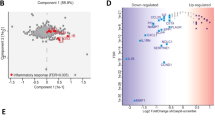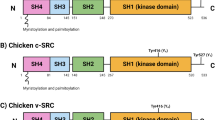Abstract
Transforming growth factor-β1 (TGF-β1) is a potent inducer of apoptosis in normal hepatocytes, and acquiring resistance to TGF-β1 may be a critical step in the development of hepatocellular carcinoma (HCC). In this study, we investigated the possible involvement of c-Src in the regulation of TGF-β1-induced apoptosis. TGF-β1 induced transient activation of c-Src and its subsequent caspase-mediated degradation concomitant with cell death in FaO hepatoma cells, which are sensitive to TGF-β1. In response to TGF-β1, activated c-Src was translocated into the cytoplasmic membrane, then relocated to the nuclei of apoptotic cells during its cleavage. In TGF-β1-induced apoptotic cells, c-Src maintained its tight association with p85 FAK fragment cleaved by caspases, possibly contributing to focal adhesion disassembly. TGF-β1-induced apoptosis was enhanced by either inhibition of c-Src activity using PP1 or PP2, or by overexpression of dominant-negative c-Src. In contrast, overexpression of constitutively active c-Src inhibited apoptosis suppressing TGF-β1-induced activation of p38, JNK and caspases. In many HCC cell lines resistant to TGF-β1, enhanced c-Src activity was detected. We hypothesize that activated c-Src in HCC may contribute to resistance against the apoptotic and/ or antiproliferative properties of TGF-β1.
This is a preview of subscription content, access via your institution
Access options
Subscribe to this journal
Receive 50 print issues and online access
$259.00 per year
only $5.18 per issue
Buy this article
- Purchase on Springer Link
- Instant access to full article PDF
Prices may be subject to local taxes which are calculated during checkout








Similar content being viewed by others
Abbreviations
- TGF-β1:
-
transforming growth factor-β1
- HCC:
-
hepatocellular carcinoma
- PBS:
-
phosphate-buffered saline
- PAGE:
-
polyacrylamide gel electrophoresis
- TUNEL:
-
terminal deoxynucleotidyl transferase-mediated deoxyuridine triphosphate nick-end labeling
- SDS–PAGE:
-
sodium dodecyl sulfate/polyacrylamide gel electrophoresis
- DN:
-
dominant negative
- CA:
-
constitutively active
- GFP:
-
green fluorescence protein
References
Abou-Shady M, Baer HU, Friess H, Berberat P, Zimmermann A, Graber H, Gold LI, Korc M and Buchler MW . (1999). Am. J. Surg., 177, 209–215.
Biscardi JS, Tice DA and Parsons SJ . (1999). Adv. Cancer Res., 76, 61–119.
Choi KS, Eom YW, Kang Y, Ha MJ, Rhee H, Yoon JW and Kim SJ . (1999). J. Biol. Chem., 274, 31775–31783.
Choi KS, Lim IK, Brady JN and Kim SJ . (1998). Hepatology, 27, 415–421.
Crouch DH, Fincham VJ and Frame MC . (1996). Oncogene, 12, 2689–2696.
de Caestecker MP, Piek E and Roberts AB . (2000). J. Natl. Cancer Inst., 92, 555–557.
Furuta K, Misao S, Takahashi K, Ta gaya T, Fikuzawa Y, Ishikawa T, Yoshioka K and Kakumu S . (1999). Int. J. Cancer, 81, 851–853.
Gervais FG, Thornberry NA, Ruffolo SC, Nicholson DW and Roy S . (1998). J. Biol. Chem., 273, 17102–17108.
Ijichi H, Ikenoue T, Kato N, Mitsuno Y, Togo G, Kato J, Kanai F, Shiratori Y and Omata M . (2001). Biochem. Biophys. Res. Commun., 289, 350–357.
Ito Y, Kaswakatsu H, Takeda T, Sakon M, Nagano H, Sakai T, Miyoshi E, Noda K, Tsujimoto M, Wakasa K, Monden M and Matsuura N . (2001). J. Hepatol., 35, 68–73.
Ito N, Kawata S, Tamura S, Takaishi K, Shirai Y, Kiso S, Yabuuchi I, Matsuda Y, Nishioka M and Tarui S . (1991). Cancer Res., 51, 4080–4083.
Jones RJ, Brunton VG and Frame MC . (2000). Eur. J. Cancer, 36, 1595–1606.
Jong HS, Lee HS, Kim TY, Im YH, Park JW, Kim NK and Bang YJ . (2002). Biochem. Biophys. Res. Commun., 292, 383–389.
Jove R, Kornbluth S and Hanafusa H . (1987). Cell, 50, 937–943.
Kanamaru C, Yasuda H and Fujita T . (2002). Hepatol. Res., 23, 211–219.
Kawate S, Takenoshita S, Ohwada S, Mogi A, Fukusato T, Makita F, Kuwano H and Morishita Y . (1999). Int. J. Oncol., 14, 127–131.
Kim SG, Jong HS, Kim TY, Lee JW, Kim NK, Hong SW and Bang YJ . (2004). Mol. Biol. Cell, 15, 420–434.
Kim BC, Mamura M, Choi KS, Calabretta B and Kim SJ . (2002). Mol. Cell. Biol., 22, 1369–1378.
Lee JH, Ku JL, Park YJ, Lee KU, Kim WH and Park JG . (1999). World J. Gastroenterol., 5, 289–295.
Lobo M and Zachary I . (2000). Biochem. Biophys. Res. Commun., 276, 1068–1074.
Masaki T, Okada M, Tokuda M, Shiratori Y, Hatase O, Shirai M, Nishioka M and Omata M . (1999). Hepatology, 29, 379–384.
Massague J . (1998). Annu. Rev. Biochem., 67, 753–791.
Massague J . (2000). Nat. Rev. Mol. Cell Biol., 1, 169–178.
Park HJ, Kim BC, Kim SJ and Choi KS . (2002). Hepatology, 35, 1360–1371.
Park JG, Lee JH, Kang MS, Park KJ, Jeon YM, Lee HJ, Kwon HS, Kim ST and Park JG . (1995). Int. J. Cancer, 62, 276–282.
Parson SJ, McCarley DJ, Ely CE, Benjamin DC and Parsons JT . (1984). J. Virol., 51, 272–282.
Schaller M . (2001). Oncogene, 20, 6459–6472.
Schaller MD, Hildebrand JD, Shannon JD, Fox JW, Vines RR and Parsons JT . (1994). Mol. Cell. Biol., 14, 1680–1688.
Schlaepfer DD and Hunter T . (1996). Mol. Cell. Biol., 16, 5623–5633.
Schwartzberg PL . (1998). Oncogene, 17, 1463–1468.
Song K, Cornelius SC, Reiss M and Danielpour D . (2003). J. Biol. Chem., 278, 38342–38351.
Wrana JL . (2000). Cell, 100, 189–192.
Wen LP, Fahrni JA, Troie S, Guan JL, Orth K and Rosen GD . (1997). J. Biol. Chem., 272, 26056–26061.
Wildey GM, Patil S and Howe PH . (2003). J. Biol. Chem., 278, 18069–18077.
Wilkes MC, Murphy SJ, Garamszgi N and Leof EB . (2003). Mol. Cell. Biol., 23, 8878–8889.
Yakicier MC, Irmak MB, Romano A, Kew M and Ozturk M . (1999). Oncogene, 18, 4879–4883.
Acknowledgements
We sincerely thank Dr Edward B Leof for providing antiphospho-Smad3 antibody. This work was supported by Korea Research Foundation Grant (KRF-2000-F00045).
Author information
Authors and Affiliations
Corresponding author
Rights and permissions
About this article
Cite this article
Park, S., Eom, YW., Kim, E. et al. Involvement of c-Src kinase in the regulation of TGF-β1-induced apoptosis. Oncogene 23, 6272–6281 (2004). https://doi.org/10.1038/sj.onc.1207856
Received:
Revised:
Accepted:
Published:
Issue Date:
DOI: https://doi.org/10.1038/sj.onc.1207856
Keywords
This article is cited by
-
TGF-β – an excellent servant but a bad master
Journal of Translational Medicine (2012)
-
The Pathophysiology of Epithelial-Mesenchymal Transition Induced by Transforming Growth Factor-β in Normal and Malignant Mammary Epithelial Cells
Journal of Mammary Gland Biology and Neoplasia (2010)
-
Expression of Src and FAK in Hepatocellular Carcinoma and the Effect of Src Inhibitors on Hepatocellular Carcinoma In Vitro
Digestive Diseases and Sciences (2009)
-
Involvement of Src Tyrosine Kinases (SFKs) and of Focal Adhesion Kinase (FAK) in the Injurious Mechanism in Rat Primary Neuronal Cultures Exposed to Chemical Ischemia
Journal of Molecular Neuroscience (2009)
-
β3Integrin and Src facilitate transforming growth factor-β mediated induction of epithelial-mesenchymal transition in mammary epithelial cells
Breast Cancer Research (2006)



